

TWO-DIMENSIONAL SHEAR VISCOSITY OF MODEL LUNG SURFACTANT PI: Joe Zasadzinski Antonia Barba Allan Hancock College Mentor: Coralie Alonso INSET PROGRAM Molecular Engineering Group Dept. of Chemical Engineering University of California, Santa Barbara Funding: National Institute of Health and the State of California
Abstract TWO-DIMENSIONAL SHEAR VISCOSITY OF MODEL LUNG SURFACTANT The lung surfactant (LS) is a film (monolayer) that lines the lung alveoli, which is necessary for normal lung compliance and ease of breathing. The unique mixture of lipids and proteins reduces the surface tension at the air-alveoli interface, thus reducing the work of breathing and preventing the collapse of alveoli upon exhalation. A lack or dysfunction of LS induces respiratory problems such as Neonatal Respiratory Stress Disorder (NRDS) in infants. The current treatment for NRDS lies in replacement LS extracted from animals but quantities available are rather small and there is a risk of viral contamination. A synthetic LS should present the same physical properties as the natural LS, particularly it should present a rigid phase at high surface pressure. Our project focuses on the effect of the protein SP-B on the monolayer viscosity. Using a Magnetic Needle Viscometer, isotherm and viscosity measurements can be taken. Isotherms show the pressure of SP-B, as the molecular area increases with SP-B concentration. Viscosity measurements show an increase in the maximum viscosity with an increase in SP-B concentration. The results agree with the fact that SP-B interacts specifically with the lipid POPG by helping this relatively fluid lipid to build 3-D structures upon compression.
Lung Surfactant Babies born premature presenting respiratory disease can be treated with natural surfactant, but the amount of lung surfactant depends on the weight of a person. Then the synthetic formula is needed to treat adults.
Role of Lung Surfactant rigid enough to prevent alveoli collapse Inspiration Inspiration Exhalation reduce the work of breathing by reducing surface tension
Composition of Lung Surfactant The lung surfactant is made up of a unique mixture of proteins and lipids. Each play an important role in the model lung surfactant. The main components are: Lipids: DPPC - reduces surface tension and increases viscosity POPG - re-spreading agent and lowers viscosity PA - aids in DPPC molecule alignment Protein: SP-B ???? SP-C ????
Magnetic Needle Viscometer Set-up :
Isotherm and viscosity measurements of DPPC Velocity vs. Time 14 12 10 needle speed (mm/s) 8 6 4 2 0 0 2 4 6 8 10 12 14 16 time (s.)
Brewster Angle Microscopy Images Pictures courtesy of Junqi Ding’s thesis, UCSB With SP-B the domains are less numerous, but larger.
Results: Interaction of SP-B and lipid mixture DPPC:POPG:PA:dSP-B1-25 70:22:8:10 DPPC:POPG:PA:dSP-B1-25 70:22:8:5 DPPC:POPG:PA 70:22:8 70 5 DPPC:POPG:PA:dSP-B1-25 70:22:8:15 60 DPPC:POPG:PA:dSP-B1-25 70:22:8:10 DPPC:POPG:PA:dSP-B1-25 70:22:8:5 DPPC:POPG:PA 70:22:8 4 Drag Coeffcient (mSurf.Poise) 50 Surface Pressure (mN/m) 40 3 30 2 20 1 10 0 0 0 50 100 150 200 250 300 0 10 20 30 40 50 2 ) Area / Molecule (Å Surface Pressure (mN/m) The viscosity increases sharply at the plateau and increases with SP-B concentration.
What’s next? . DPPC:POPG:PA:SP-C ff 70:22:8:x ! Investigate the effect of on saline buffer at 25C 70 the protein SP-C on the no SP-C 60 5% viscosity of the lipid 10% 15% 50 mixture. Surface Pressure (mN/m) 40 ! Take pictures of the domains. 30 20 10 0 50 100 150 200 Area / Molecule (Å 2 )
Acknowledgements : • Materials Research Laboratory, University of California at Santa Barbara • National Science Foundation (NSF) • Funding Source: National Institute of Health and State of California • INSET Program, University of California at Santa Barbara • Mentor: Coralie Alnoso • PI: Joe Zasadzinski
Recommend
More recommend